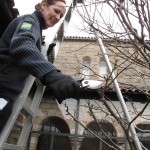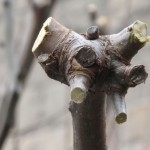 |
 |
 |
A medieval technique of hard pruning, known as pollarding, is used on the four crab apple trees in Cuxa Cloister garden to control the height of the trees and the spread of their canopies. The pruning is done in late winter, while the trees are still dormant.
Above:??Frances Reidy, our arborist, cutting last spring’s growth back to the same “head” as the previous spring’s. This successive hard pruning produces the “knuckles” of tissue characteristic of pollarded trees. This is the third year in which the technique has been applied; the knuckles at the head of the branches will become more pronounced as the pollard matures.
Although pollards are usually created when a tree is very young, we are applying this technique to our mature crab apples in order to solve a?? problem. In 2008, we realized that these trees had??grown so tall and wide??that they??were obscuring??the medieval architecture of Cuxa Cloister and shading out the lawns and beds of the garden. On the expert advice of our arborist, Frances Reidy, we decided to reduce the size of the canopies by resorting to??a medieval technique known as pollarding.??In order to transform the crab apples into??pollards,??we needed??to perform the necessary??pruning over the course of three years. (If we cut the trees back by more than a third at a time, we would risk sending them??into shock.) Ms. Reidy is now working on the third and final phase of the transformation, but the pollards will have to be cut back to the same point every year, a task that will be taken on by the gardens staff.
Pollarding is sometimes used in modern horticulture to control size or to enhance ornamental effects such as flowering or fruiting. However, the medieval technique was developed as a form of woodland management, and was intended to produce successive crops of young shoots from selected species of trees, such as willow or ash. The new growth was produced well above ground level and was thus protected from browsing animals. Once harvested, the wood could be put to many practical purposes.
More on pollarding in the Middle Ages to come…
???Deirdre Larkin
Tags: ash, crab apple, Cuxa Garden, pollarding, willow

February 25, 2011 at 1:59 pm
Very interesting post, Deirdre! Thanks for sharing the information.
February 26, 2011 at 3:32 pm
Ah, good stuff indeed. A good source of material for wattle fencing, no? A question for Ms Reidy, are certain species of tree more readily adapted to this kind of treatment, or can any tree be pollarded?
March 1, 2011 at 12:11 pm
Wow. Fascinating! We visited last spring for one of Ms. Reidy’s lecture/tours and loved hearing from the Cloisters own horticulturalist the history, care and challenges faced in tending to such a beautiful space.
May 15, 2013 at 11:07 am
[...] were carefully managed to generate a steady stream of useful timber. Techniques like coppicing and pollarding let people harvest wood without killing the trees. Good forest management was complemented by all [...]
June 30, 2013 at 10:46 am
[...] but pollarding is a practice that has been used to keep trees small for centuries in Europe: Woodswoman, Pollard That Tree | The Medieval Garden Enclosed | The Metropolitan Museum of Art, New Y… I actually (cough) had this done to a tree that I inherited, and I had to explain what it was to [...]
January 16, 2014 at 10:03 am
[...] Read about the fascinating??”medieval technique of hard pruning, known as pollarding” in this article, Woodsman, Pollard That Tree. [...]